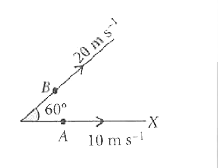A particle moves with a uniform velocity.
The particle must be at rest.
The particle moves along a curved path.
The particle moves along a circle.
The particle moves along a straight line
The correct Answer is:D
Topper's Solved these Questions
Similar Questions
The acceleration vector of a particle moving with a uniform velocity is a ____ vector.
View SolutionAssertion: In successive time intervals if the average velocities of a particle are equal then the particle must be moving with constant velocity.
Reason: When a particle moves with uniform velocity, its displacement always increases with time.
View Solution
Knowledge Check
A particle moves with uniform velocity. Which of the following statements about the motion of the particle is true?
AIts speed is.zeroBIts acceleration is zeroCIts acceleration is opposite to the velocityDIts speed may be variable.A particle moves with uniform velocity. Which of the following statements about the motion of the particle is true?
AIts speed is.zeroBIts acceleration is zeroCIts acceleration is opposite to the velocityDIts speed may be variable.Assertion: In successive time intervals if the average velocities of a particle are equal then the particle must be moving with constant velocity.
Reason: When a particle moves with uniform velocity, its displacement always increases with time.AIf both assertion & Reason are True & the Reason is a corrrect explanation of the Asserion.BIf both Assertion & Reason are True but Reason is not correct explanation of the Assertion.CIf Assertion is Trie but the Reason is False.DIf both Assertion & Reason are false
A charged particle moving with a uniform velocity →v enters a region where uniform electric and magnetic fields →E and →B are present. It passes through the region without any change in its velocity. What can we conclude about the (i) relative direction of →E, →V and →B? (ii) magnetic of →E and →B?
or
Find the condition under which the charged particle moving with different speeds in the presence of electric and magnetic field vectors can be used to select charged particles of a particular speeds.
View SolutionParticle A moves along X-axis with a uniform velocity of magnitude 10 m/s. Particle B moves with uniform velocity 20 m/s along a direction making an angle of 60° with the positive direction of X-axis as shown in the figure. The relative velocity of B with respect to that A is

View SolutionWhich of the following statement is true about a particle moving with uniform velocity ?
View SolutionIf a particle is moving with uniform velocity 20 m//s on a circular track of radius 10 m, then the magnitude of change in velocity in half revolution will be
View SolutionA particle moving with uniform speed
View Solution
